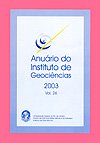Search for bioindicators of pollution in the Guanabara Bay: integrations of ecologic patterns
DOI:
https://doi.org/10.11137/2003_0_25-35Abstract
Guanabara Bay, since its discovery, has largely changed with the human occupation causing large amounts of deposited sediment and waste, as well as domestic and industry sewage. Surface sediment was analysed for foraminifera and ostracoda distribution, diversity and dominance studies. These results were compared with TOC analyses aiming the determination of pollution bioindicators. In general, foraminifera dominant species were Ammonia tepida, Buliminella elegantissima and Quinqueloculina seminulum. The foraminifera assemblages presented distinct abundance and diversity values in different regions of the bay. The diversity was higher in the entrance (south) and in the central region than in the north region of the bay. The dominant species, that are characteristic of stressed environments, presented higher values of abundance in the north region. The TOC values increased from south to north regions, and were inversely proportional to foraminifera diversity. The very high TOC values in very polluted areas suggest sediment deposition in anoxic-dysoxic environment. The ostracoda Gen. Cyprideis was dominant and its occurrence increased from south to north region. Occurrence of Callistocythere sigmocostata, Xestoleberis sp., Aurila sp., and Paracypris sp. were restricted to the entrance and central area, indicating a preference for less restricted conditions, like marine conditions. Foraminifera and ostracoda characteristic responses to the environment conditions related high TOC values showed their importance as bioindicators of stressed environments caused by anthropogenic pollution, in the Guanabara Bay.Downloads
Download data is not yet available.
Downloads
Published
2003-01-01
How to Cite
Vilela, C. G. (2003) “Search for bioindicators of pollution in the Guanabara Bay: integrations of ecologic patterns”, Anuário do Instituto de Geociências. Rio de Janeiro, BR, 26, pp. 25–35. doi: 10.11137/2003_0_25-35.
Issue
Section
Article
License
This journal is licensed under a Creative Commons — Attribution 4.0 International — CC BY 4.0, which permits use, distribution and reproduction in any medium, provided the original work is properly cited.















